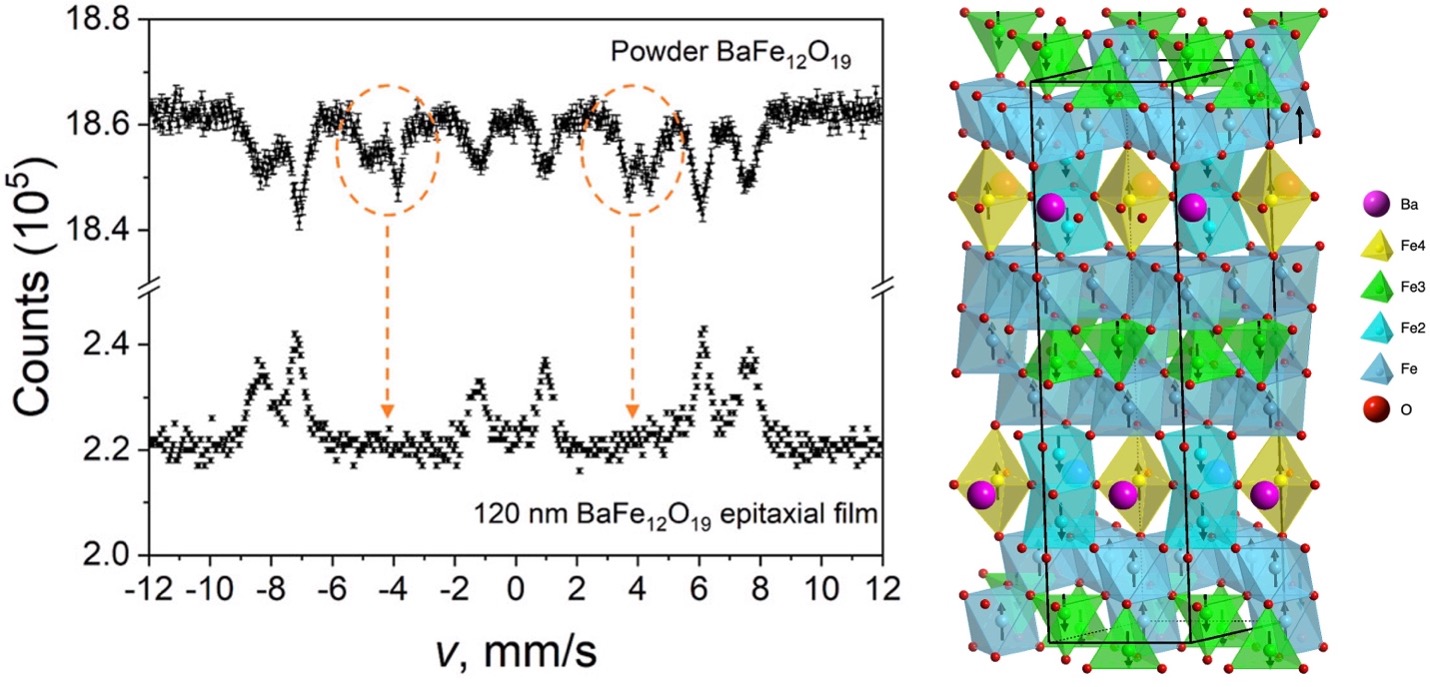PARADIM Highlight #106—External User Project (2025)
Natarajan Ravi (Spelman College) and Darrell Schlom (Cornell U.)
Mössbauer spectroscopy is a powerful way to sense the local magnetic environment around specific atoms in a crystal structure. As many PARADIM discoveries involve thin films, PARADIM users are excited to be able to now apply this technique to films by using Mössbauer spectroscopy in a backscattering geometry dubbed conversion electron Mössbauer spectroscopy (CEMS). Here, users of PARADIM together with members of the In-House Research Team grow thin films containing isotopically purified iron (57Fe) to determine the orientation of the magnetic moments of these iron atoms in single-crystal iron thin films. Next the team extends the concept to a more complex system, BaFe12O19, the common refrigerator magnet. Though common, its crystal structure is complex as shown on the right. The missing peaks in the CEMS spectrum indicate that the magnetic moments lie in the up/down direction (see Figure). The project is part of the NSF-funded PREM: Advanced Interface Materials and made use of PARADIM’s signature molecular-beam epitaxy system and the capabilities for Mössbauer spectroscopy at Spelman College.

Figure 1: (Left) Mössbauer spectra of BaFe12O19 in two forms: (Top) a randomly oriented powder and (Bottom) a single-crystal film. The dashed arrows point to missing peaks not seen in the powder. These missing peaks signify that the magnetic moments in the film lie in either up or down directions. (Right) Crystal structure with arrows on the 57Fe atoms indicating the directions of their magnetic moments.
60 and 120 nm thick epitaxial films of isotopically enriched bcc iron (α-57Fe) grown on (100) MgO substrates are studied using x-ray diffraction, reflection high-energy electron diffraction (RHEED), and conversion electron Mössbauer spectroscopy (CEMS). X-ray diffraction and RHEED data indicate that each film behaves as a single crystal material consistent with the relative intensity ratios of the spectral lines observed in the CEMS spectrum. Data further confirm that the easy axis of magnetization lies along the ⟨100⟩ family of directions of the cubic α-iron film. The relevant theory to understand the relative intensities in a magnetic Mössbauer spectrum is outlined and is applied to interpret the intensity ratio of the Mössbauer spectral lines of a more complex hexaferrite magnetic system, BaFe12O19, grown on a single crystal substrate of Sr1.03Ga10.81Mg0.58Zr0.58O19. The conclusion that the magnetic moment in (0001)-oriented epitaxial BaFe12O19 film lies perpendicular to the plane of the substrate is deduced from the absence of the second and fifth lines by comparing the CEMS spectrum of the epitaxial (0001) BaFe12O19 film with the spectrum of a polycrystalline BaFe12O19 powder. Our measurements using CEMS corroborate what is known about the direction of the magnetic easy axis in α-iron and BaFe12O19 and motivate the use of CEMS to probe more complex atomically engineered epitaxial heterostructures, including superlattices.
This work is the first in which Mössbauer spectroscopy has been applied to thin films grown in PARADIM. Mössbauer spectroscopy is a powerful way to sense the local magnetic environment around specific atoms in a crystal structure. Many PARADIM users are harnessing strain, special substrates, interfaces, dimensionality, and other thin-film approaches to modify magnetic structures. It can thus be very useful to apply Mössbauer spectroscopy to the magnetic thin films being synthesized and studied in PARADIM. Because of the small volume of thin films, Mössbauer spectroscopy is used in a backscattering geometry dubbed conversion electron Mössbauer spectroscopy (CEMS). To boost the signal, isotopically purified iron (57Fe) is used as the iron source in the MBE system when growing these films to be studied by CEMS. This paper shows the promise of the technique and other PARADIM users are already interested in using CEMS to study their 57Fe-containing epitaxial films.
The ability to rapidly change source materials in the PARADIM MBE using its retractable, differentially pumped sources makes it possible to optimize the growth of a material using an iron source with natural abundance (which is inexpensive) and then swap in an isotopically purified 57Fe source (which is expensive) to grow films to be studied by CEMS under optimized conditions.
The work was initiated by Professor Natarajan Ravi (Spelman College) via a PARADIM user proposal and assembling a team that included the user’s group, members of the PARADIM In-House Research Team, and an REU student (Jayda Shine, REU 2022).
Y.E. Li, J. Shine, C. Guguschev, M. Brützam, D.G. Schlom, and N. Ravi, “Corroborating the Magnetic Easy Axis of Epitaxial (100) α-iron and (0001) BaFe12O19 Thin Films by 57Fe Mössbauer Spectroscopy," AIP Adv. 15, 015323 (2025). DOI: 10.1063/5.0244334.
Y.E.L., J.S., D.G.S., and N.R. gratefully acknowledge the support from the National Science Foundation (NSF) through Grant No. DMR-2122147 as well as the Platform for the Accelerated Realization, Analysis, and Discovery of Interface Materials (PARADIMs) under Cooperative Grant Agreement No. DMR-2039380.
Data Availability: The data that support the findings are publicly available via the PARADIM Data Collective at DOI: 10.34863/0rh9-yn63.







